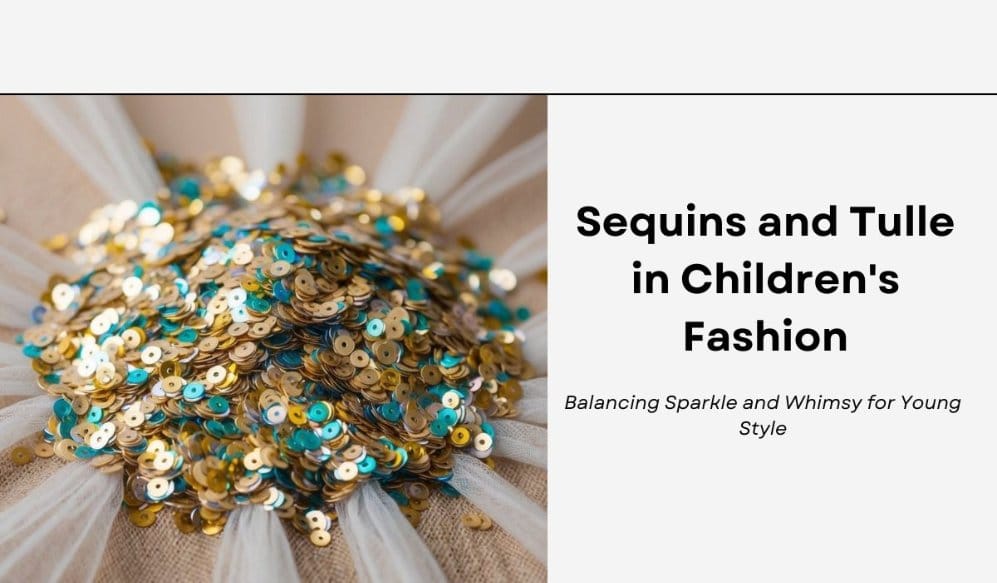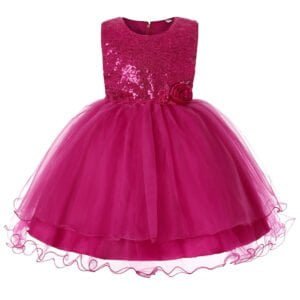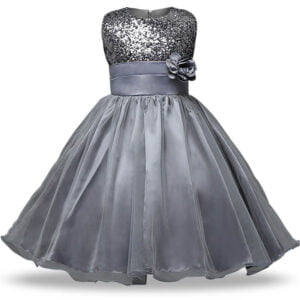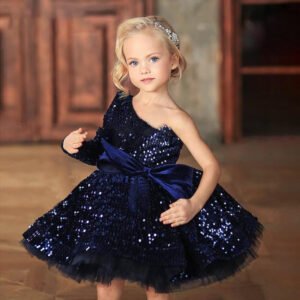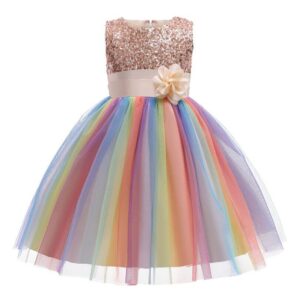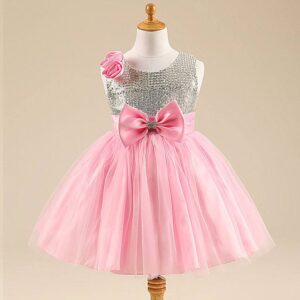When Sparkle Meets Magic: The Art of Combining Fashion’s Most Enchanting Elements
Sequins and tulle are two fabrics that bring magic to children’s fashion. When combined, they create eye-catching outfits perfect for special occasions. Sequin dresses with tulle skirts offer a delightful blend of sparkle and softness, making them popular choices for young girls.
These fabrics can be mixed in various ways to suit different styles and preferences. Some designs feature sequin embellishments on tulle overlays, while others incorporate sequin bodices with flowing tulle skirts. The versatility of these materials allows for creativity in children’s fashion, from casual jumpers with a hint of sparkle to full-on party dresses.
When shopping for sequin and tulle outfits, parents can find options for various age groups. Many retailers offer these styles for girls aged 3 to 13 years, ensuring that children of different ages can enjoy the whimsical combination of these fabrics.
On This Page
Key Takeaways
- Sequins and tulle create magical, eye-catching outfits for children’s special occasions
- These fabrics can be mixed in various ways, from subtle embellishments to full sparkly dresses
- Sequin and tulle outfits are available for a wide range of ages, typically from 3 to 13 years old
The Essentials of Sequins and Tulle in Children’s Fashion
Sequins and tulle are key elements in creating magical looks for kids. These materials add sparkle and volume to children’s outfits, making them perfect for special occasions.
Characteristics of Tulle Fabric
Tulle is a lightweight, fine netting made from silk, nylon, or rayon. It’s known for its airy and delicate appearance. Tulle comes in various colours and stiffness levels.
This fabric is often used in children’s dresses to create full skirts and fluffy layers. It’s also popular for tutus and ballet costumes.
Tulle is quite durable despite its delicate look. It resists wrinkles and holds its shape well. This makes it ideal for active children.
Care is simple – most tulle items can be hand washed or machine washed on a gentle cycle. Always check the care label for specific instructions.
Varieties of Sequins
Sequins are small, shiny discs used to decorate clothing. They come in many shapes, sizes, and colours. Round and oval sequins are common, but star and heart shapes are fun options for kids’ clothes.
Sequin dresses for girls often use flat sequins for a smooth look. Cup sequins add more texture and sparkle.
Some sequins change colour when brushed in different directions. This interactive element is exciting for children.
Plastic sequins are lightweight and budget-friendly. For a luxe feel, glass or metal sequins can be used, but these are less common in kids’ wear.
When buying sequined items for children, check that the sequins are securely attached to prevent them from falling off.
Design Principles for Combining Sequins with Tulle
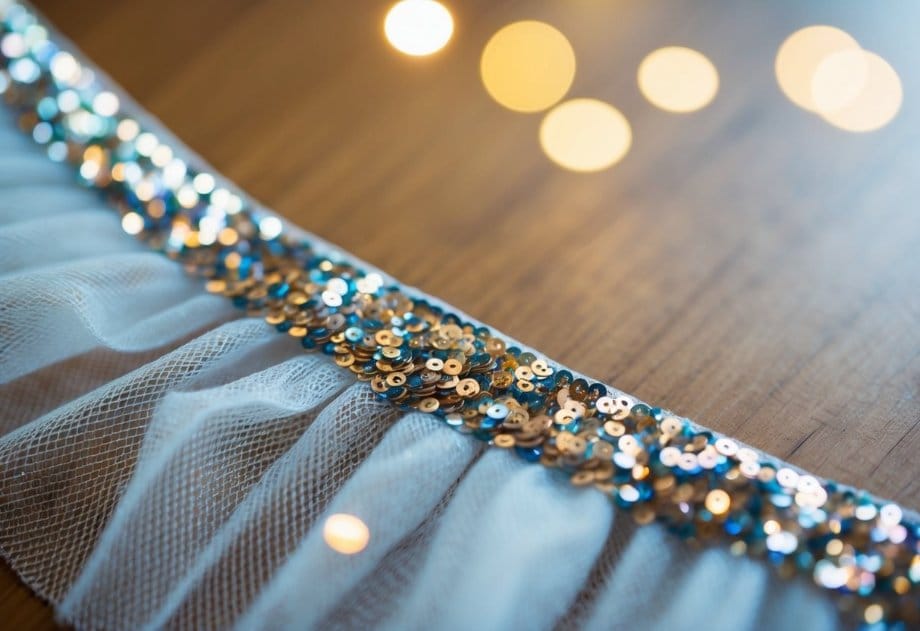
Mixing sequins and tulle in children’s fashion requires careful consideration of texture, colour, and placement. These elements work together to create eye-catching designs that are both playful and elegant.
Balancing Texture and Sheen
Sequins add sparkle and shine, while tulle brings lightness and volume. To balance these textures, consider using larger sequins on a fine tulle base. This creates a striking contrast without overwhelming the delicate fabric.
For a subtler look, try small sequins on a stiffer tulle. This combination allows the tulle’s structure to shine through while still adding a touch of glimmer.
When sewing sequins onto tulle, use a thin needle and thread to avoid damaging the delicate fabric. Secure each sequin individually for the best hold.
Colour Harmony
Choosing the right colour palette is crucial when combining sequins and tulle. Opt for sequins that complement or contrast with the tulle’s hue.
For a monochromatic look, use sequins in the same colour family as the tulle. This creates a sophisticated, cohesive appearance.
To make a bold statement, choose contrasting colours. For example, silver sequins on black tulle or gold sequins on pink tulle can create a dazzling effect.
Consider the child’s skin tone and hair colour when selecting sequin and tulle colours. This ensures the outfit flatters the wearer.
Sequin Placement Techniques
Strategic sequin placement can elevate a tulle garment from simple to stunning. Concentrate sequins at the hem or neckline for a graduated sparkle effect.
Create patterns or motifs with sequins on tulle. Stars, flowers, or abstract designs can add visual interest to a plain tulle backdrop.
For a more subtle approach, scatter sequins sparsely across the tulle. This technique works well for everyday wear or less formal occasions.
When attaching sequins near side seams, leave a small gap to allow for alterations. This ensures the garment can be easily adjusted as the child grows.
Sewing Techniques Specific to Tulle and Sequins
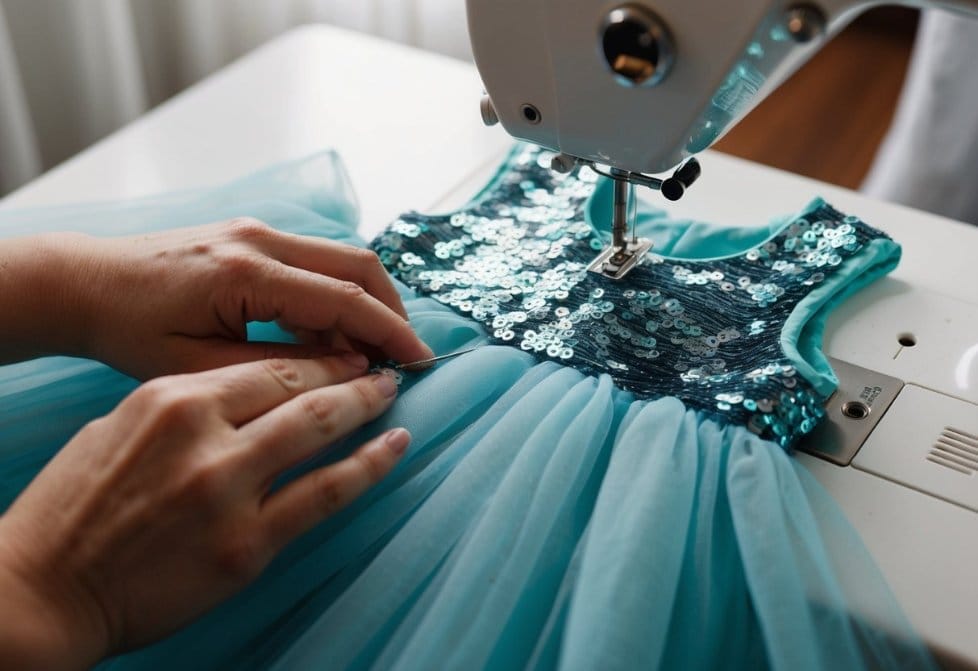
Mixing sequins and tulle requires special care and techniques. Proper stitching, fabric handling, and finishing methods ensure stunning results for children’s fashion pieces.
Stitching Sequins on Tulle
Sewing sequins onto tulle demands precision and patience. Use a small, sharp needle and thin thread to avoid damaging the delicate tulle. Work slowly, securing each sequin individually.
For machine sewing, choose a needle designed for sheer fabrics and adjust tension settings. Test on scraps first to perfect your technique.
When attaching sequin trim, hand-basting can help keep it in place before machine stitching. This prevents slipping and ensures even placement along seams or edges.
Preventing Tulle Damage
Tulle is delicate and prone to snagging. Use tissue paper between the tulle and presser foot to prevent catching or tearing during machine sewing.
Choose the right needle size – a fine, 70/10 or 65/9 needle works well for most tulle types. Replace needles often, as dull points can snag the fabric.
When ironing, use a low heat setting and a pressing cloth to protect the tulle. Avoid direct contact with the iron to prevent melting or burning.
Seam and Hem Finishes
For side seams, a French seam provides a clean, enclosed finish that won’t irritate a child’s skin. Trim seam allowances close before enclosing to reduce bulk.
Rolled hems work well for tulle skirts and dresses. Use a rolled hem foot on your sewing machine for a professional finish. Alternatively, hand-roll hems for added control on very sheer tulle.
For sequinned edges, remove sequins from seam allowances before stitching. This reduces bulk and allows for smoother seams. Re-attach sequins by hand after sewing for a seamless look.
Selecting the Right Tools and Materials
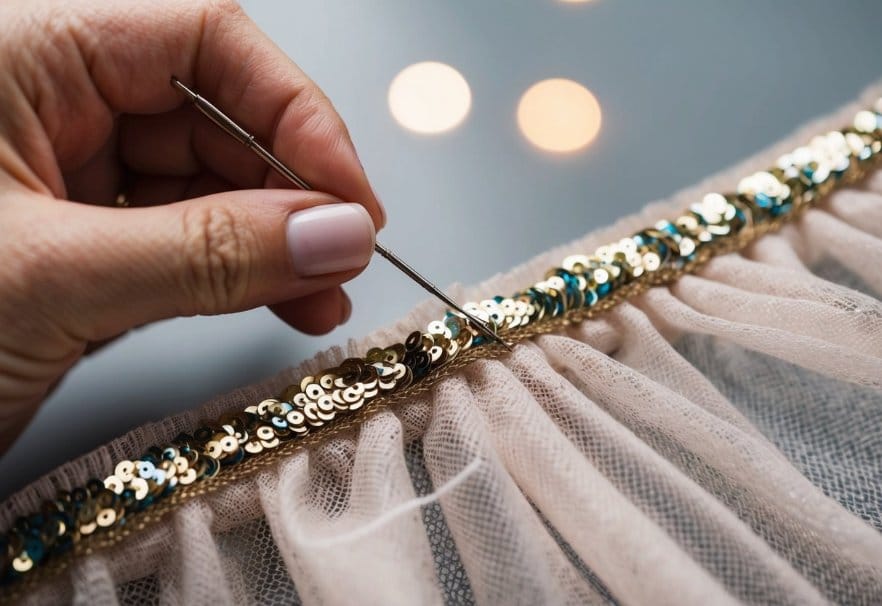
Proper tools and materials are crucial for successfully mixing sequins and tulle in children’s fashion. The right equipment ensures a polished result and makes working with these delicate fabrics easier.
Sewing Machines and Settings
A reliable sewing machine is essential for working with sequins and tulle. Choose a machine with adjustable tension and stitch length. Set the tension lower for tulle to prevent puckering. Use a longer stitch length (3-4 mm) for sequins to avoid damaging them.
For tulle, a zigzag stitch works well. A straight stitch is better for sequins. Test stitches on scraps before sewing the actual garment.
Consider using a walking foot attachment. It helps feed delicate fabrics evenly through the machine, reducing slipping and bunching.
Threads and Needles for Sequin and Tulle
Select the right thread and needle for each fabric. For tulle, use a fine polyester thread and a sharp, small needle (size 70/10 or 80/12). This combination prevents snags and visible holes.
With sequins, opt for a stronger thread like polyester or nylon. A larger needle (size 90/14 or 100/16) is needed to pierce through sequins without breaking.
Thread and Needle Guide:
- Tulle: Fine polyester thread, 70/10 or 80/12 needle
- Sequins: Strong polyester/nylon thread, 90/14 or 100/16 needle
Cutting and Handling Sheer Fabrics
Cutting and handling sheer fabrics like tulle requires care. Use sharp scissors or a rotary cutter for clean edges. Place tissue paper under tulle when cutting to prevent slipping.
When pinning tulle, use fine pins to avoid leaving marks. Place pins in seam allowances where possible. For sequins, remove individual sequins from seam allowances before sewing to prevent needle breakage.
Handle both fabrics gently to avoid snagging or distorting. Keep your work surface clean and smooth to prevent catching or tearing.
Store cut pieces flat or rolled to maintain their shape. Avoid folding tulle as it can create permanent creases.
Working with Tulle: Best Practices
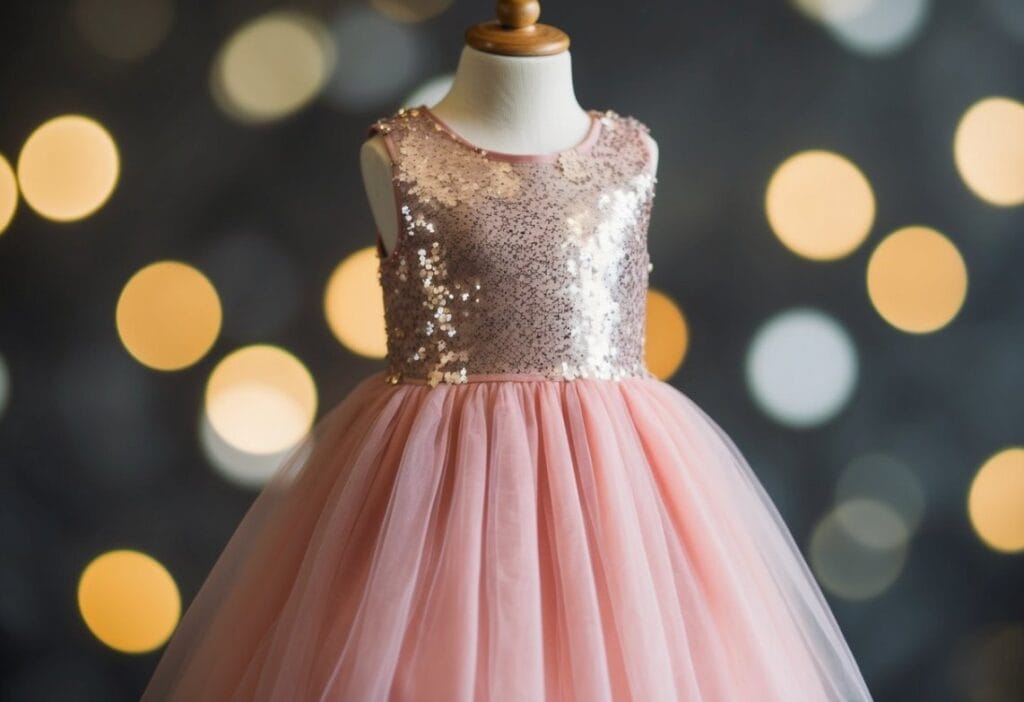
Tulle is a delicate fabric that requires special care and techniques. Using the right methods can help achieve beautiful results when incorporating tulle into children’s fashion designs.
Layering Tulle for Fullness
To create voluminous skirts and dresses, layering tulle is key. Start with a base layer of stiffer tulle for structure. Add softer tulle layers on top, gradually increasing the fullness. Alternate colours or shades for depth and visual interest.
Gather each layer separately before attaching to the waistband. This allows for better control of the fullness. Use a longer stitch length when gathering tulle to prevent tearing.
For maximum pouf, consider using a petticoat or crinoline underneath. This adds lift and shape to tulle skirts.
Handling and Storage
Proper handling and storage are crucial for maintaining tulle’s appearance. Always use clean hands when working with tulle to avoid snagging or transferring oils.
Store tulle garments hanging in cotton garment bags. This prevents creasing and protects the delicate fabric. Avoid folding tulle, as this can create permanent creases.
When ironing is necessary, use a low heat setting. Place a clean cloth between the iron and tulle to prevent melting. Steaming is often a safer option for removing wrinkles from tulle.
Sewing Tips for Tulle
Sewing tulle requires patience and the right techniques. Use a new, sharp needle to prevent snagging. A size 70/10 needle works well for most tulle fabrics.
Choose the appropriate stitch for your project. A straight stitch works for most seams, while a narrow zigzag adds flexibility for gathered areas. Set the stitch length to 2.5-3.5 mm for best results.
Instead of pins, use clips to hold tulle in place. This prevents holes and snags in the fabric. When sewing layers of tulle, use a walking foot to feed all layers evenly through the machine.
For a professional finish, use French seams or roll the edges. This encases raw edges and prevents fraying. Trim any loose threads carefully to maintain a neat appearance.
Incorporating Sequins in Children’s Wear Safely

Sequins add sparkle to children’s clothing but require careful consideration for safety and practicality. Proper attachment, age-appropriate designs, and proper care ensure sequined garments remain fun and safe for little ones to wear.
Secure Attachment for Safety
Sequins on dresses and other children’s garments must be firmly attached to prevent choking hazards. Double-stitching or heat-sealing sequins provides extra security. Avoid loose or dangling sequins that could easily detach.
For infants and toddlers, opt for sequins that are part of the fabric print rather than sewn-on pieces. This eliminates risks while still providing sparkle.
Check garments regularly for any loose sequins. Remove or repair them immediately to maintain safety.
Selecting Age-Appropriate Designs
Choose sequin designs suitable for a child’s age and activities. For younger children, select garments with sequins in small, concentrated areas rather than full coverage.
Matte sequins offer a subtler sparkle and may be more appropriate for everyday wear. They’re less likely to snag or catch on objects during play.
Consider reversible sequin fabrics for older children. These provide interactive fun while being more securely attached than individual sequins.
Maintenance and Care
Proper care extends the life of sequined clothing and keeps it safe. Always check care labels for specific instructions.
Hand washing is often best for sequined items. Use cool water and gentle soap to avoid damaging sequins or loosening their attachment.
When machine washing is acceptable, use a mesh laundry bag to protect the garment. Choose a gentle cycle with cold water.
Air dry sequined clothing flat to prevent stretching or distortion. Avoid ironing directly on sequins, as heat can melt or damage them.
Store sequined items flat or hung carefully to prevent snagging or crushing of the sequins.
Trends and Inspirations in Children’s Sequined and Tulle Outfits
Sequins and tulle are key elements in today’s children’s fashion. These fabrics bring sparkle and whimsy to special occasion wear for kids.
Recommended products
Baby girl sequin dress – Dark pink
Price range: £18.99 through £22.99Flower girl sequin tulle dress – Grey
£18.99Girl one shoulder sequin dress
£79.99Girl rainbow sequin dress – Gold
£20.99Girls sequin party dress
£7.99
Current Trends in Sequins and Tulle
Rainbow sequins are a hot trend in children’s clothing. They add fun pops of colour to dresses and tops. Tulle skirts in bright hues are also popular.
Many outfits mix sequin bodices with tulle skirts. This blend creates eye-catching looks for parties and events. Short tulle sleeves add a soft touch to sequined tops.
Waterfall tulle skirts paired with sequined tops are gaining favour. These sparkly dresses often feature bows at the waist for extra flair. Ruffled tulle tiers are also trendy in skirts and dresses.
Incorporating Cultural Influences
Global styles are shaping children’s sequin and tulle fashions. Indian-inspired sequin patterns add rich detail to party frocks. African print fabrics mixed with tulle create bold, unique looks.
Asian-influenced designs often use sequins to create delicate floral motifs. These pair well with soft tulle overlays. Middle Eastern styles may include gold sequins on colourful tulle for a luxe feel.
Mexican-inspired dresses might feature bright sequin embroidery on layers of tulle. European influences bring classic silhouettes updated with modern sequin placement and tulle textures.
Navigating Online Resources for Children’s Fashion
The internet offers a wealth of tools and communities for exploring children’s fashion trends. Parents and designers can find inspiration and guidance for mixing sequins and tulle through various online platforms.
Utilising the Browser for Design Ideas
Web browsers serve as gateways to vast fashion resources. Parents can use search engines to find captivating ensembles that combine sequins and tulle. Popular retailers’ websites often showcase trendy looks.
Fashion-focused social media platforms like Pinterest and Instagram are goldmines for visual inspiration. Users can create boards or collections of their favourite styles.
Online marketplaces such as Amazon and H&M offer extensive selections of children’s sequin and tulle garments. These sites allow users to filter by size, colour, and style.
Online Tutorials and Communities
Video-sharing platforms host numerous tutorials on mixing sequins and tulle in children’s outfits. These videos often provide step-by-step guidance for creating unique looks.
Fashion blogs and forums are excellent resources for tips and discussions. Parents can join these communities to share ideas and ask questions about combining textures and styles.
Online courses offer in-depth learning experiences for those interested in children’s fashion design. These courses may cover textile selection, pattern creation, and styling techniques.
E-books and digital magazines provide comprehensive guides on children’s fashion trends. Many offer seasonal advice for incorporating sequins and tulle into various outfits.
Frequently Asked Questions
Mixing sequins and tulle in children’s fashion brings up several key questions about comfort, style, care, and safety. These practical considerations help parents make informed choices when selecting sparkly tulle outfits for their little ones.
How can sequins be incorporated into children’s tulle dresses without compromising comfort?
Sequins can be added sparingly to tulle dresses, focusing on areas that don’t rub against the skin. Sequin accessories like belts or small embellishments on bodices work well. Soft-backed sequin fabrics provide comfort when used for larger areas.
What are the trending patterns for sequin embellishments on children’s tulle garments?
Popular patterns include scattered sequins on tulle skirts, creating a starry effect. Geometric shapes and floral designs are also trendy. Some dresses feature ombré sequin patterns, gradually fading from dense to sparse.
How does one maintain the quality of tulle and sequin fabrics in children’s wear through wash and wear?
Hand washing or using a delicate cycle is best for tulle and sequin garments. Cold water and mild detergent help preserve the fabrics. Turning the garment inside out protects sequins during washing.
What safety considerations should be taken into account when adding sequins to children’s clothing?
Securely attached sequins are crucial to prevent choking hazards. Rounded sequins are safer than sharp-edged ones. It’s important to check for loose sequins regularly and remove them if necessary.
What occasions are most suitable for children to wear tulle and sequin outfits?
Tulle and sequin outfits are perfect for special occasions like birthday parties, holidays, and formal events. They’re also popular for dance recitals and school performances.
How can sequins be securely attached to children’s tulle clothing to prevent them from coming loose?
Professional-grade fabric glue works well for attaching sequins to tulle. Sewing sequins individually provides the most secure attachment. For larger areas, using pre-sequined fabric that’s securely stitched to the tulle is effective.
Related Post: 20 Facts About Tulle: Unveiling the Secrets of This Versatile Fabric

